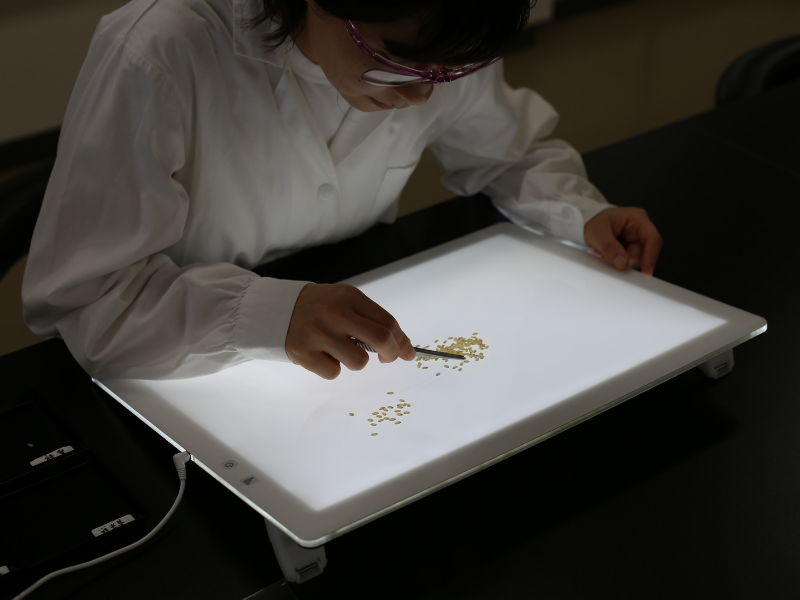
this is not something any of us were aware of. The bottom line is that nitrogen availability needs to be narrowly managed or the product is inferior.
I do think that nitrogen rich biochar needs to be closely investigated as this may well solve hte dosage problem directly.
Nitrogen management is been slowly forced into our agriculture and biochar is our best chance to fix it.
To fertilizer or not to fertilize: A delicate balance between chalky rice grains and excessive protein content
Readings from two devices show potential to help farmers find middle ground
March 30, 2022 - There’s a widespread problem in rice growing that you’ve probably never heard of. Rice plants that face elevated temperatures can produce “chalky grains” that are easily crushed during the milling process. This leads to lost profits because the price is lower for chalky grains than undamaged grains.
Nitrogen fertilizer can reduce the production of chalky grains. However, too much nitrogen can cause an increase in rice protein levels. Too much protein affects the quality of rice in an undesirable way because of its lower viscosity when cooked.
This means that applying nitrogen fertilizer is a delicate balance between preventing chalky grains and keeping protein at an acceptable level. Hiroshi Nakano, a researcher at the Kyushu Okinawa Agricultural Research Center, National Agriculture and Food Research Organization in Japan, and collaborators are researching one potential solution.
This study was recently published in the Agronomy Journal, a publication of the American Society of Agronomy.
Farmers can use the tools to predict the chalky grain percentage and protein content in the field. This will allow them to assess how much nitrogen fertilizer they need in real-time. “Our goal is to facilitate the stable production of rice in a changing climate,” Nakano says. “It is important to establish an ideal nitrogen application rate using growth diagnosis. In this study, we identified useful factors to regulate white-back grains (one type of chalky grain) and protein content.”
He adds that in Southwestern Japan, rice seedlings are transplanted from mid to late June. The rice grains develop through processes that occur in July, August, and October. There are slight differences in weather and growth each year. This means the exact needs for nitrogen are not always the same. The result is the nitrogen application needs to be adjusted based on growth conditions.
“Our mission is to develop ways to protect rice from global climate change,” Nakano says. “In Japan, rice production areas account for approximately 36% of all farming land. In recent years, rice plants have been exposed to higher air temperatures during the ripening stage. This can result in white-back grains.”
In their study, the researchers tested two types of measurements using two devices. One looked at the concentration of nitrogen in the leaves of the rice plants. The other measure how much of a plant can uptake nitrogen. The team also determined the best times to take these measurements.
Their findings point to the usefulness of the readings for allowing farmers to make real-time adjustments to nitrogen application at an important time during rice production.
Heading is the stage of rice growth before flowering. Timing the measurements at the correct time in the plants’ development helped reduce the amount of some chalky grains and regulate the grain protein content.
“We recommend that farmers conduct the growth diagnosis by using handheld meters,” Nakano says. “These meters are not expensive, and getting this information will allow them to harvest rice grains with high quality.”
However, it can be difficult for farmers to get enough data if they have lots of rice fields. The researchers hope to develop a way to take these measurements using an unmanned aerial vehicle. Nakano adds that being able to help farmers enhance their rice yields while maintaining high quality is important for solving food security issues. A growing global population and rising temperatures are causing these food security issues.
“This research is broadly important as the global average temperature is predicted to increase due to global warming,” Nakano says. “The occurrence of white-back grains increases when rice plants ripen under high air temperatures. Rice is a staple food of approximately 50% of the global population. Therefore, this issue is important for farmers but also for consumers.”
Support for this research was provided by Japan’s National Agriculture and Food Research Organization Biooriented Technology Research Advancement Institution.
Photo Caption: Technician Chiemi Nagamatsu analyzes rice grain appearance to determine the effect of nitrogen application rates during the vegetative and reproductive stages of the growth cycle. Nitrogen fertilizer can reduce the production of chalky grains. However, too much nitrogen can cause an increase in rice protein levels, and too much protein can make rice unfit to eat. Credit: Hiroshi Nakano.
No comments:
Post a Comment